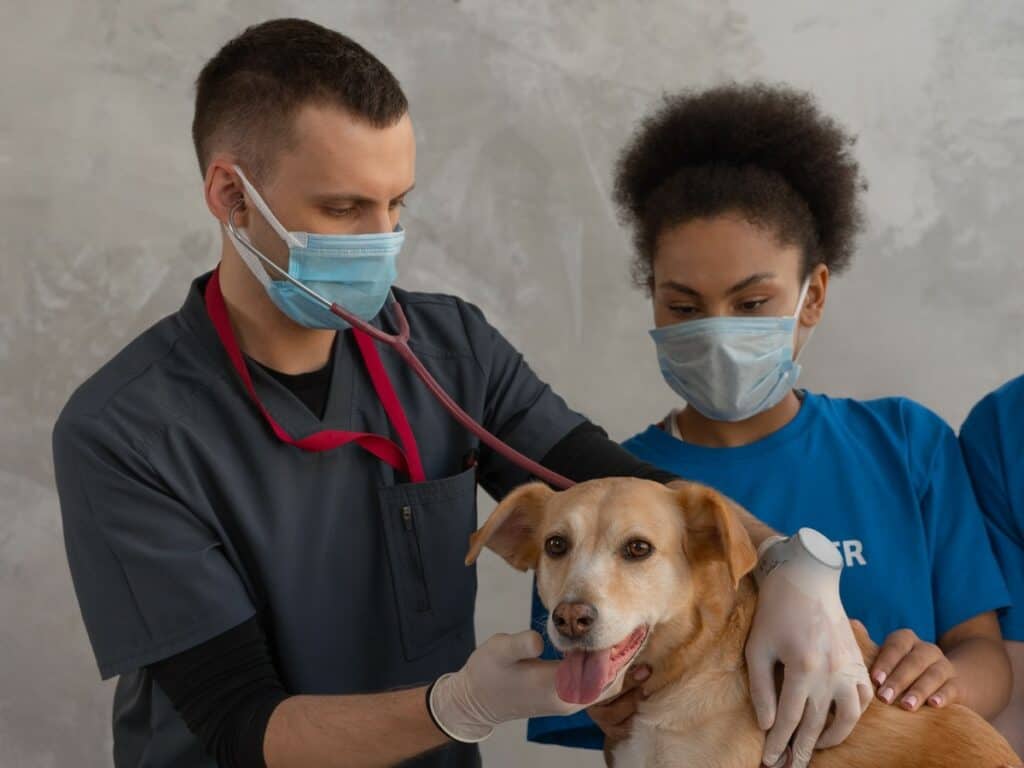You know that constant sensation of having something stuck in your throat? That’s called “gag,” and it’s not pleasant. But gags in dogs are even worse when they’re unable to throw up. Uncomfortable feelings are always present — and we wish our pets could just puke so they’d feel better after releasing their stomach contents.
If your dog is gagging but not throwing up, there could be several reasons for this. The most common reason is that your dog has something lodged in his throat. Other causes include kennel cough, hairballs, bloat, canine laryngeal paralysis, and intestinal parasite.
Read on and learn more about these causes so you can get your dog the help they need.

Common Reasons for a Dog Gagging But Not Throwing Up
Here are six of the most common reasons why dogs gag without throwing up:
Foreign Object
One of the most common reasons for a dog gagging but not throwing up is because they swallow something they shouldn’t. Some commonly ingested items include small objects, feminine products, clothing, string, bones and meat skewers, jewelry, and toys.
Some things small enough to pass through a dog’s digestive tract may be eliminated with poop and cause no problems. If the item is small enough, then it won’t cause any damage to the puppy. You can use disposable popsicle sticks or a piece of thin, sharpened metal to cut up the poop and look for the item inside.
On the other hand, ingested sharp objects could cut into your dog’s intestines, causing internal bleeding and possibly peritonitis. In addition, obstructions caused by foreign bodies can prevent blood from flowing properly to the bowels, leading to death.

The subsequent injury may become irreversible if the obstruction is not promptly dealt with. Once located, the item will be removed. The vet can often perform this procedure via endoscopy, either down the dog’s esophagus, up through his anus, or surgically. In any case, the internal injury is repaired. If surgery is performed before peritonitis sets in, most dogs make a full recovery.
Kennel Cough
A common symptom associated with kennel cough is the constant presence of a dry, hacking cough that sounds like your pet has something stuck in its mouth. Often the dog will gag or heave at times when they cough.
Kennel cough is usually caused by various viruses and bacterial infections that enter the lungs through inhalation. It usually clears up on its own within three weeks, but there are some things you can do at the house to help keep your dog feeling better when he has kennel cough.
For example, by keeping the dog in a humid environment, you may be able to relieve the dryness and ease the symptoms associated with kennel cough. If necessary, you could use a portable humidifier to increase the humidity level in the room.
If the dog shows signs of severe illness or if the infection isn’t healing on its own, it’s time to consult the vet.
Hairballs
Hairball development is not uncommon for dogs. However, if they collect in your pet’s stomach, they may lead to your dog gagging but not throwing up. If your dog vomits out the hairball, there’s nothing to worry about. However, if it does not, the hairball will deny your dog vital fluids, leading to dehydration.
A hairball in a dog can cause serious health issues if it blocks its digestive system. If your dog has trouble digesting, take them to your veterinarian for an examination.
If you notice your pet constantly licking themselves excessively, it may be because they’re eating too much hair. It’s well worth finding out why they’re doing so and taking steps to address the issue. Not only will this stop them from lapping up excess hair, but it will also improve their overall well-being by tackling any underlying conditions such as skin problems, parasites, and an allergy.
Hairballs are also closely associated with what you’re feeding your pet. Hence, high-fiber food can help move hairballs through the digestive tract. It’s also essential to ensure your pet receives plenty of water so things continue moving smoothly within the digestive tract.
Gastric Dilatation Volvulus
Gastric Dilatation Volvulus (GDV), also known as bloat, is a life-threatening medical emergency that usually occurs in large, deep-chested dogs. Bloat is caused by excessive amounts of air trapped within the gastrointestinal tract. When the amount of air becomes too great, the intestine begins to twist around itself, causing severe pain and possible death.
As well as resulting in a dog gagging but not throwing up, GDV also causes drooling, white foam, lethargy, rapid breathing, pale gums, accelerated heart rate, and a hard or swollen stomach.
So, how is GDV treated? Veterinarians begin by treating the shock. When the dog is stable, they take him into the operating room. They perform two operations. First, they deflate the stomach and then rotate it back to its original position. If the stomach lining was torn, they remove that part. Next, they attach the stomach to the abdominal cavity so it won’t twist.
Canine Laryngeal Paralysis
Dogs with canine laryngeal paralysis may sound noisy when they breathe and pant. This is because their throat cartilage covers part of the way through which the air passes into the lungs. Also, dogs with this condition may experience gagging but not throwing up when they eat. This is because the larynx allows water and food into the trachea.
Surgery is the only option for treating dogs with severe laryngeal paralysis. It involves tying back the larynx so the dog can breathe normally again.
Read also: Why Is My Baby Pug Breathing Hard?
Intestinal Parasites
Dogs can acquire intestinal parasites through various means. Parasites may be ingested when dogs eat contaminated soil, drink contaminated groundwater, eat contaminated food, or ingest fecal material from another dog.
Meanwhile, puppies usually acquire parasitic worms from their mothers during pregnancy or nursing. Transmission occurs in utero or from breastfeeding.
Why should you care? Intestinal parasites can cause gagging in dogs, weight loss, and diarrhea.
And while the idea that intestinal parasites might infect your pet may give you the creeps, these parasites are easily treated and even easier to prevent than most people realize. Talk to your vet about the necessary treatment plan for your dog’s intestinal parasites.
Read also: Help! My Puppy Has Hiccups All The Time – Is That Normal?
Final Thoughts
As a fur parent, you probably already understand that dogs often throw up when they eat too fast or something irritates their stomach. So if your pet throws up without showing any other signs of discomfort, you don’t have to panic.
But if you notice that your dog looks like he’s trying to force something out of his stomach (yet nothing comes out), your dog:
- has something trapped in their airway;
- has kennel cough;
- has collected hairballs in their stomach;
- has gastric dilatation volvulus;
- has canine laryngeal paralysis; and
- has intestinal parasites.
By recognizing these reasons for your dog gagging but not throwing up, you can assess if any of them applies to your pet. And if so, you can seek veterinary care as soon as possible.
Related Questions
What should I do if my dog is gagging?
The treatment plan will vary depending on the cause of your dog’s gagging. Medications, including antibiotics and steroids, are often used to treat dogs suffering from diseases or illnesses requiring short-term treatments. Surgery may be required if your dog has laryngeal paralysis or gastric dilatation-volvulus.
Why does my dog keep gagging and throwing up white foam?
Gastric distress is one of the most common reasons dogs throw up white foam. If your pet has indigestion and no longer has anything left in their digestive system to expel, they might begin vomiting this foamy, whitish substance.
How do you help a dog that is trying to throw up?
Contact your vet immediately if your pet has been gagging but not throwing up, especially if their tummy is bloated. These are signs of gastric dilatation-volvulus (GDV).
How do you tell if your dog has something stuck in its throat?
Besides gagging, your dog will experience the following if they have something stuck in their throat: hacking or coughing, pawing at the throat or mouth, restlessness, vomiting, repeated swallowing, and excessive drooling.
References
Culp, W. T., & Holt, D. E. (2010). Septic peritonitis. Compend Contin Educ Vet, 32(10), E1-14.
Monnet, E. (2003). Gastric dilatation-volvulus syndrome in dogs. Veterinary Clinics: Small Animal Practice, 33(5), 987-1005.
Kitshoff, A. M., Van Goethem, B., Stegen, L., De Rooster, H., & Vandekerckhove, P. (2013). Laryngeal paralysis in dogs: An update on recent knowledge. Journal of the South African Veterinary Association, 84(1), 1-9.
Harvey, J. B., Roberts, J. M., & Schantz, P. M. (1991). Survey of veterinarians’ recommendations for treatment and control of intestinal parasites in dogs: public health implications. Journal of the American Veterinary Medical Association, 199(6), 702-707.




